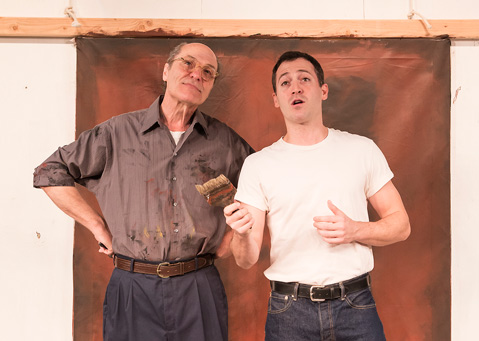Ensemble Theatre Company Tackles Rothko in Red
John Logan’s Award-Winning Play Opens at the New Vic

Does art really matter? Can creative expression lift us beyond the mundane, inspire us to think and feel differently, or even change our lives?
It’s getting harder to make that claim, at a time when so much of the art world has given in to commercialization. But in the post–World War II era, American artists were very serious about producing work designed to open minds and hearts. Think of John Coltrane’s dissonant jazz or Arthur Miller’s Death of a Salesman.
And then there was abstract expressionist Mark Rothko, one of the greatest painters of the era. He hoped to evoke a sense of transcendence in the viewer — to tap into our repressed or forgotten ability to feel awe. As UCSB art historian Laurie Monahan puts it, “He believed that art has the power to take us away from materialism and let us experience something profound.”
That belief would be sorely tested today. Just last week, on the front page of the New York Times, journalist Carol Vogel casually referred to “the growing number of collectors willing to spend more than $25 million on a single Picasso or Rothko.” From being the antidote to materialism, great art like his has become an egregious example of it.
Rothko’s internal battle to stay true to his principles is a major theme of Red, which Ensemble Theatre Company will open tonight at the New Vic. The multi-award-winning play by John Logan, author of (among other things) the screenplay for Skyfall, the most recent James Bond film, is a portrait of Rothko the artist, the mentor, the egotist, the philosopher.
“I think of my pictures as dramas,” Rothko once wrote. “The shapes in pictures are the performers.” It’s an odd statement for a man who worked with abstract forms, but Brian Shnipper, director of the Ensemble production, sees the similarities.
He took a close look at the Museum of Modern Art’s Rothkos on a trip to New York a couple of months back — at times standing inches from the canvases — and realized that “reproductions — even high-definition photos — don’t do them justice.
“He used a kind of thin, glaze-like paint,” Shnipper explained. “His paintings [consist of] anywhere from 25-30 layers, which seem to bleed through one another. With so many colors present, it’s not always clear which is dominant and which is submissive.”
That same dynamic plays out in Red, in the sparring between Rothko (Matt Gottlieb) and his young apprentice (Shaun Anthony), who gradually comes to question his mentor’s motives. Specifically, he raises the question of why Rothko has agreed to paint a series of works to be hung in a new high-end restaurant in New York City. Does he really expect patrons will give them more than a glance? Can one feel a sense of the sublime between courses?
“Rothko was quoted as saying his true intention in the Seagram murals was to paint ‘something that will ruin the appetite of every son of a bitch who eats in that room,’” Monahan said with a laugh. “It is weird that he accepted the commission in the first place. For him, the worst thing the paintings could be were decorations. His idea was you would become enveloped in a painting and have almost a spiritual relationship with it.”
Even with their spiritual aspirations, of course, paintings are physical objects, and much of Red dramatizes the process of creating them. “It is a work play,” Shnipper noted. “You get to see art being made, from the stirring of pigments to the stretching of canvasses.”
For all of the eloquent talk about art, arguably the play’s most memorable scene is a wordless one, in which the two men prime a canvas as classical music plays in the background. “These two men are breathlessly working together,” Shnipper said. “It’s like sex in that it starts slowly, crescendos, and then after the climax, it comes to an end.”
Red originally opened at the Donmar Warehouse in London in 2009, with Alfred Molina as Rothko. It moved to Broadway in 2010 — Shnipper sat in the front row at an early preview — ultimately winning the Tony Award for best play. It moved on to the Mark Taper Forum in Los Angeles in 2012, with Molina reprising his acclaimed performance.
In that original production, the set consisted of a reasonably realistic representation of Rothko’s studio. Ensemble is going in a decidedly different direction. “It has realistic elements of Rothko’s studio, such as the Chock full o’Nuts coffee cans and all the jars of pigments,” Shnipper said. “But I wanted to create a space that almost felt like a church.”
All the better to symbolize the spiritual quest of an artist who insisted that transcendent experiences required abandoning all forms of security, including one’s “plastic bankbook.”
“There was a certain amount of naïveté to his attitude,” Monahan said, “but he lived his principles.”
4•1•1
Ensemble Theatre Company presents Red at the New Vic (33 W. Victoria St.) this Thursday through Sunday, June 1. For tickets and info, call (805) 965-5400 or visit ensembletheatre.com.



